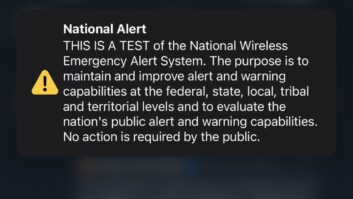Among the many veteran engineers listening to the post-test EAS debate is Warren Shulz, chief engineer of Cumulus station WLS(AM/FM) in Chicago.
For 14 years he was a member of the Primary Entry Point Advisory Committee, a group that advises FEMA and is made up of representatives from each of the PEP stations. Those stations play an important role in the EAS distribution infrastructure. Shulz was involved with the PEP program since its inception in 1991. He’s also a former SECC chair in Illinois for 14 years, so he’s familiar with the system and the people at the federal government who work on the program.

iStockphoto/Joe Gough
Radio World asked him his perspectives on what happened in the Nov. 9 national test and how the government should proceed next.
He said FEMA, with input from the PEP advisory group, has been working in recent years to improve the infrastructure that links the government with the Primary Entry Point stations, but that for now, it continues to use a linking bridge. Noise and return leakage on the bridge with 60+ participants, he said, can become part of the message audio. (FEMA has not confirmed details of exactly what happened during the national test.)
Shulz believes the EAN activation system using the linking bridge had seen three full exercises before, but that the last full testing actions were in 2007. Since then, as RW has reported, the number of PEP stations has expanded.
“Individual PEP station pre-testing did occur” before the national test, Shulz said, “but one PEP station testing at a time would not reveal the flaws when all are joined as a 60+ group for the audio message.” In hindsight, he said, the system should have been tested with a Required Weekly Test, with audio, to the entire PEP group of stations. He believes better results could have been produced during the national test “if a few Required Weekly Tests with audio were conducted of the PEP system in the overnight period to reveal the flaws and provide ongoing confidence testing.”
Based on what he heard in the test and from his contacts since then, Shulz feels the IPAWS organization next needs to help FEMA’s Federal Operations Center (FOC) to stabilize the audio component of an EAN alert.
“The suggestion I sent to the PEPAC board after the test was to have the PEP stations remove the PEP ENDEC units from the active air chain. After confirmation, the FEMA FOC should start a frenzy of testing actions using the Required Weekly Test (RWT) with audio, to ‘tune up’ the linking bridge as many times as needed to make it work. RWT code would not propagate and any release would not a critical event. They could test hundreds of times to be certain all is working as expected.”
Then, Shulz believes, FEMA’s FOC should conduct several overnight RWTs of the PEP station group, with audio, over several months, to confirm that the repairs are effective. Then repeat the national EAN test exercise.
To avoid possible technical problems, Shulz also feels FEMA should use pre-recorded scripts stored in a digital audio playback unit to be assured no extraneous noise enters the system from an open microphone.
Shulz also was pleased the audio test had been shortened from three minutes. “I doubt any station manager would have stayed with that audio message performance if it was three minutes long. In the Chicago Operational Area, the very bad audio was muted out when the ghost EAN header appeared in the first five seconds of the audio message, so the Chicago Operational Area had a silent test until the EOM was sent and test was terminated. Had it gone long many broadcasters would have aborted the test.”










